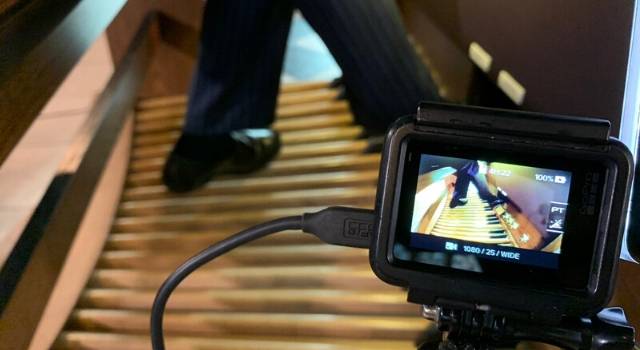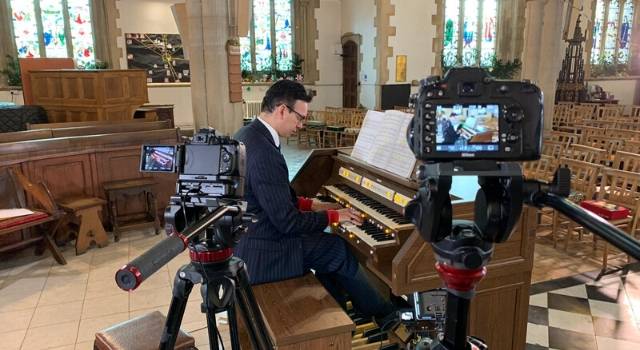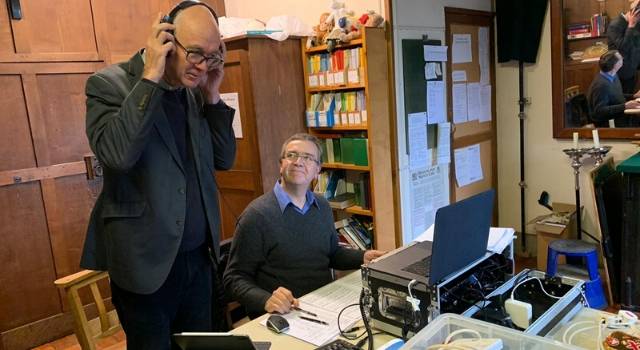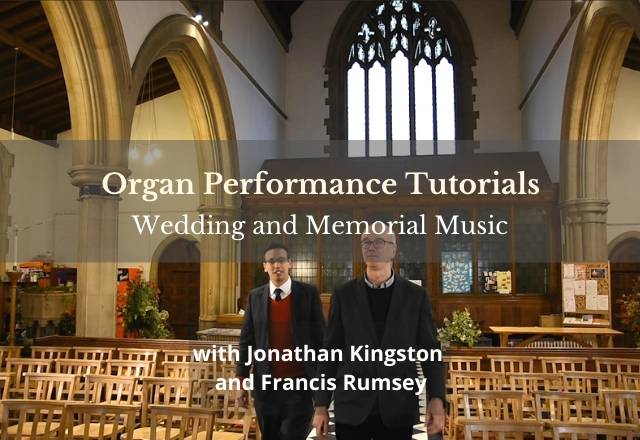Our organ performance tutorials for 2020 concentrate on the playing of organ arrangements for weddings and memorial services. Often requested, this music is a regular feature of many organists’ work. Most of the pieces we’ve chosen to feature in our organ performance tutorials can be performed successfully on a wide range of different instruments.
All the pieces we present in the series are arrangements of works for ensembles. There aren’t any hard and fast rules about how such things should be rendered for the organ. Within the limits of good taste, several options are possible, and we highlight one option for each case.
At the start of each of the organ performance tutorials, Francis Rumsey discusses the performance of each piece with Jonathan Kingston, before Jonathan performs the entire work.

Overview of the Organ Performance Tutorials
There are six organ music tutorials in the series, which will be released at regular intervals throughout the year, so be sure to look out for them.
- For our first piece in this year’s series we take a look at “Nimrod” from the Enigma Variations by Edward Elgar. Suitable for Remembrance Day, or the beginning or end of a funeral service, this is a useful, solemn organ piece, which needs careful management of dynamics.
- In the second tutorial, Jonathan and Francis look at the Solemn Melody by Walford Davies. Rather like Nimrod, this piece can be played at the end of a funeral. Originally scored for cello, strings, and organ, we’re aiming at a broad melodic sweep here.
- “Jesu Joy of Man’s Desiring” by J.S. Bach is a relatively gentle piece that’s popular for weddings, perhaps at the signing of the registers, but could also suit a memorial service.
- The fourth piece featured in our organ performance tutorials series is Handel’s “Arrival of the Queen of Sheba”. It’s a lively piece to end a wedding with.
- At number five, Pachelbel’s Canon in D seems to be a current favourite for the opening bridal procession at weddings. It was originally an imitative canon for three violins and continuo, but we need to find a way of rendering it in an interesting way on the organ.
- Finally, Mendelssohn’s Wedding March from “A Midsummer Night’s Dream” is a perennial favourite for the grand finale of a wedding service, and in many ways it’s hard to beat.

The making of our Wedding and Memorial Music Series
For this year’s organ tutorial series we chose the setting of St Margaret’s Church in north Oxford, where our colleague Richard Goodall is in charge of the music. It has sympathetic acoustics and sits in a relatively quiet road, although the challenge of silencing people that start mowing grass or cutting down trees seems to follow us wherever we try to record things.
In these videos, you’ll see and hear Jonathan Kingston playing a Viscount Envoy 35-F Physis-based digital organ, which offers a lot of registration flexibility over two manuals and pedals. It was installed with external loudspeakers in St Margaret’s for the recording and voiced specifically for the installation.

With Francis as producer, the team included Adrian Lucas as recording engineer and James Atkinson as videographer, who both worked hard to get some great shots and a splendid sound for these recordings.
Previous years’ tutorials can be found on our organ music blog or go directly to the Organ Registration Tutorial (2019) or Choral Organ Accompaniment Series (2018).
Looking for more ideas on music to play during a wedding? Then look at our suggestions for organ wedding music.
I have had a passion for church organs since the tender age of 12. I own and run Viscount Organs with a close attention to the detail that musicians appreciate; and a clear understanding of the benefits of digital technology and keeping to the traditional and emotional elements of organ playing.




The creme rises to the top.
“Finally Mendelssohn’s Wedding March from “A Midsummer Night’s Dream” is a perennial favourite for the grand finale of a wedding service, and in many ways it’s hard to beat.”
My former Rector would not allow this nor “Here Comes the Bride”, because they had tragic consequences. However, you offer good things for a good product. I was fortunate to be in such a place with standards. I am appalled by the low quality of liturgical music in many places.